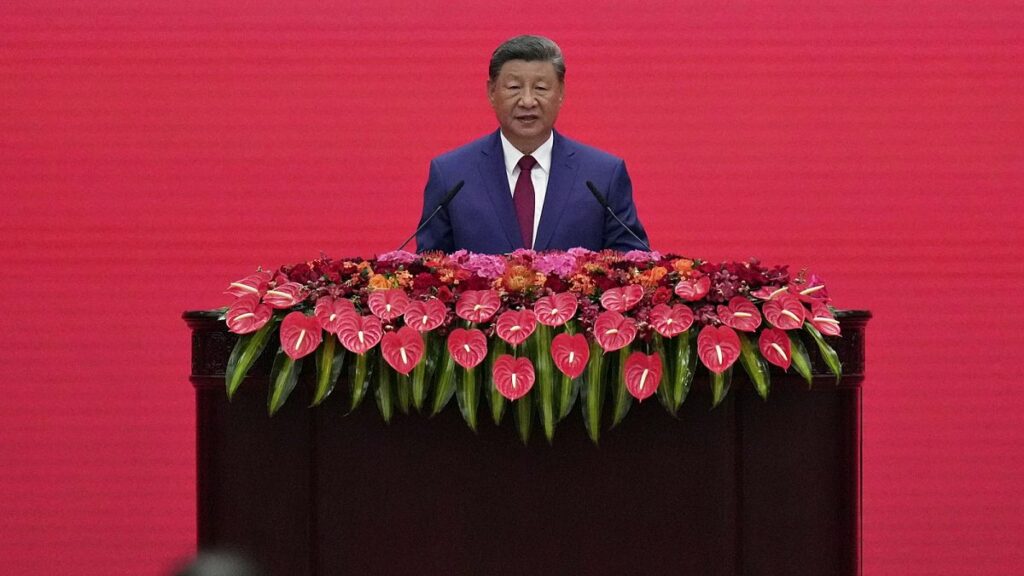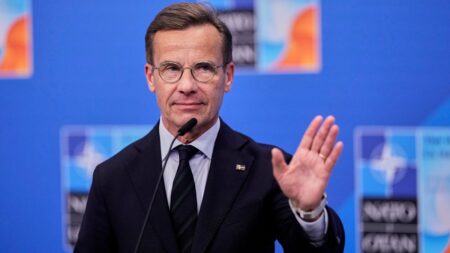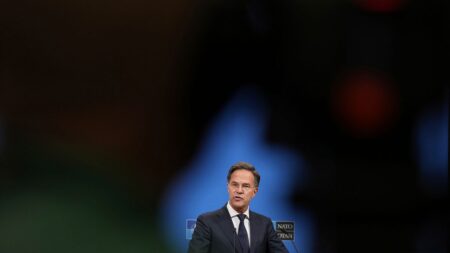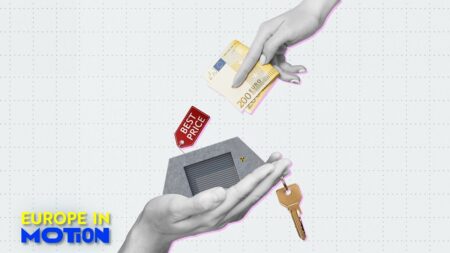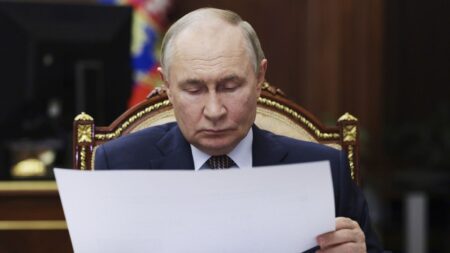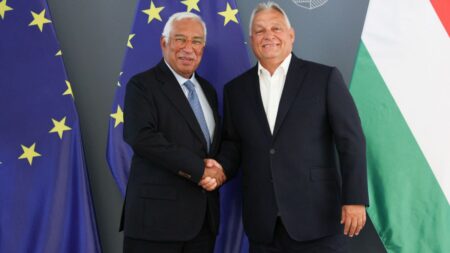Donald Trump has thrown down his gauntlet: he wants European nations to impose 50% to 100% tariffs on China as part of a joint strategy to counter Russia’s invasion of Ukraine.
The demand, which had already leaked to the press, became official US policy when the president made it public on a social media post over the weekend.
In his “letter”, as he called it, Trump argued the punishing tariffs on China, coupled with an immediate end to all purchases of Russian oil, would be of “great help” to end “this deadly but ridiculous war”.
“China has a strong control, and even grip, over Russia, and these powerful Tariffs will break that grip,” he wrote.
The timing of the request was eye-catching: it came amid growing coordination efforts between the two sides of the Atlantic to intensify economic pressure on the Kremlin and force President Vladimir Putin to sit at the negotiating table.
Last week, US Treasury Secretary Scott Bessent met with the European Union’s sanctions envoy, David O’Sullivan, in Washington, and US Energy Secretary Chris Wright met with High Representative Kaja Kallas and Energy Commissioner Dan Jørgensen in Brussels. On Friday, G7 finance ministers held a call centred on sanctions.
But Trump’s message dashed hopes that a new common front might soon emerge.
While Brussels voiced readiness to accelerate the phase-out of Russian fossil fuels, it pushed back rather decisively against the request for the three-digit tariffs.
“Any new measures to be announced in the 19th sanctions package will be fully in line with EU rules and procedures, notably the long-held principle that our sanctions do not apply extra-territorially,” said a spokesperson of the European Commission.
Privately, diplomats were franker: no way.
Legal interpretation
There are at least three key reasons why the bloc will not go down the go-for-broke avenue suggested by Trump.
First, the EU separates tariffs, a trade tool, and sanctions, a foreign policy tool.
The European Commission, which determines commercial policy for the 27 member states, introduces tariffs to address specific cases of market disturbances, most notably unfair competition. These duties are generally based on the results of an in-depth probe that runs for months and complies with World Trade Organization (WTO) rules.
Even when the executive proposed steep tariffs on Russian agricultural goods, which reinforced the sanctions regime, it did so under the premise of protecting domestic farmers against Moscow’s production surplus and illegal seizures of Ukrainian grain.
By contrast, Trump doesn’t distinguish between the two. For him, tariffs are sanctions – and vice versa.
Trump has unleashed duties to accomplish a variety of objectives, such as forcing countries into lopsided deals, encouraging US firms to reshore their production, raising extra revenue for the treasury, castigating India for buying Russian oil and lambasting the judicial case of Brazil’s former president Jair Bolsonaro.
Earlier this year, the White House launched an all-out trade war with China which, at its peak, saw tariffs soar to 145% rates, making trade impossible. Feeling the heat, the two sides entered a truce to negotiate a stable agreement. As a result, the US lowered its tariffs to 30%, far below the 100% level that Europeans are now expected to enforce.
Trump’s anything-goes approach to tariffs has been widely contested, prompting a legal case that now heads to the Supreme Court and threatens to unravel his entire agenda.
“The EU should avoid blanket punitive tariffs on China of the magnitude proposed by Mr Trump. Such measures would undermine the global trading system and are more likely to harm the European economy than to weaken Russia,” said Engin Eroglu, a German MEP who chairs the European Parliament’s delegation for relations with China.
“Tariffs that are not compliant with WTO rules are the wrong path forward.”
Disparate views
Second, the EU lacks the political consensus to mount such an unprecedented, radical offensive against China, one of its largest trading partners.
Although member states have in recent years hardened their stance on Beijing, frustrated by industrial overcapacity, discriminatory regulations and information manipulation, they have never found themselves on the same page.
The divisions came to the fore in 2024 when Brussels proposed tariffs on China-made electric vehicles to offset the effects of subsidies. The duties, which ranged from 7.8% to 35.3%, were considered the litmus test of Ursula von der Leyen’s “de-risking” agenda.
The day of the final decision, 10 countries voted in favour of the measures, 12 abstained and five, including Germany, voted against. (The Commission broke the impasse.)
The headline-making split, which experts linked to Beijing’s behind-the-scenes lobbying, encapsulated the bloc’s struggle to close ranks.
Despite the EU repeatedly accusing China of being the “key enabler” of Russia’s invasion of Ukraine and supplying 80% of the components needed to manufacture weapons, it has never moved forcefully to curb its trade relations as a result.
The “Anti-Circumvention Tool”, which can prohibit the sale, supply and transfer of sensitive goods and technology to any country suspected of aiding the Kremlin’s war machine, has lain dormant since its introduction two years ago. The tool, effectively secondary sanctions, requires the unanimity of all 27 member states.
Instead, the EU has opted to blacklist a hand-picked number of entities based in mainland China and Hong Kong. Moving from this piecemeal approach to 100% tariffs overnight would be improbable, to say the least.
Tit-for-tat
Third, the EU is perfectly aware of the risks at play.
China is known for retaliating against any foreign decision that it deems detrimental to its national interests. In the case of the EVs, Beijing opened investigations into EU exports of pork, dairy and brandy, which Brussels dismissed as unjustified.
In spring, China took things further when it restricted exports of seven rare earth elements that are crucial for the automotive, energy, technology and defence sectors. The move coincided with Trump’s “reciprocal” tariffs but had a global effect.
Von der Leyen decried the curbs as “blackmail” and eventually negotiated a solution to provide relief for the European industry. Still, the show of force rattled capitals, which saw the ease with which Beijing could inflict economic pain with the stroke of a pen.
Following Trump’s proposal, China did not wait long to warn those who might be entertaining the idea of 100% tariffs: do it at your own peril.
“China firmly opposes the relevant party directing the issue at China and abusing illicit unilateral sanctions and long-arm jurisdiction against China,” Lin Jian, the spokesperson of the Chinese foreign ministry, said on Monday.
“If China’s legitimate rights and interests are harmed, China will resolutely take countermeasures to safeguard our sovereignty, security and development interests.”
With economic stagnation at home and trade tensions abroad, the bloc is unlikely to muster the courage for such a high-voltage policy, particularly given Trump’s track record of U-turning on sanctions, which could leave Europeans out in the cold.
“Trump’s maximalist demands only serve to highlight that he is not serious about imposing economic pressure on Russia. His self-imposed deadlines have passed with no action being taken,” Maria Shagina, a senior fellow at the International Institute for Strategic Studies (IISS), told Euronews.
“By making US sanctions contingent on the participation of all NATO countries, the expectation is that nothing will happen.”
Read the full article here







